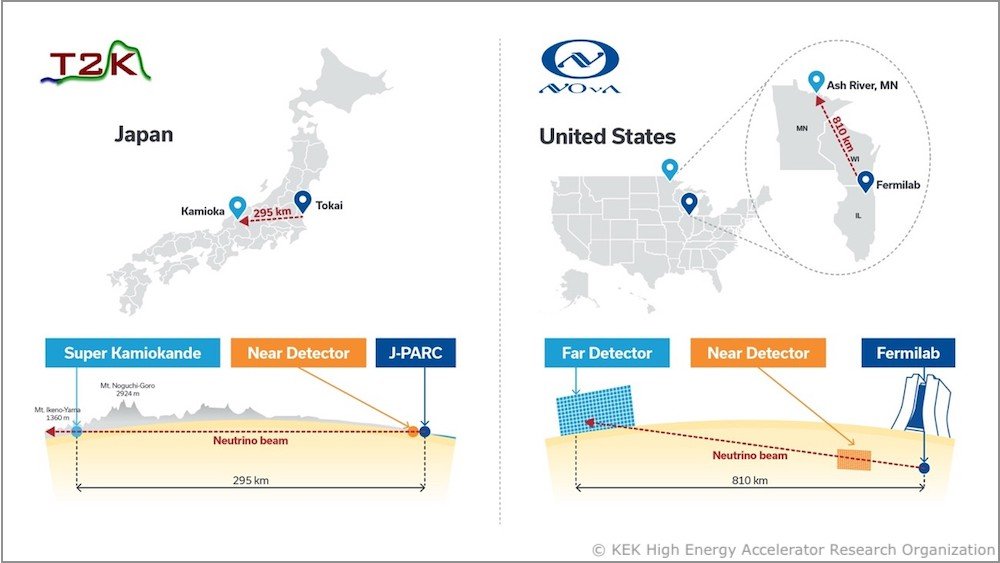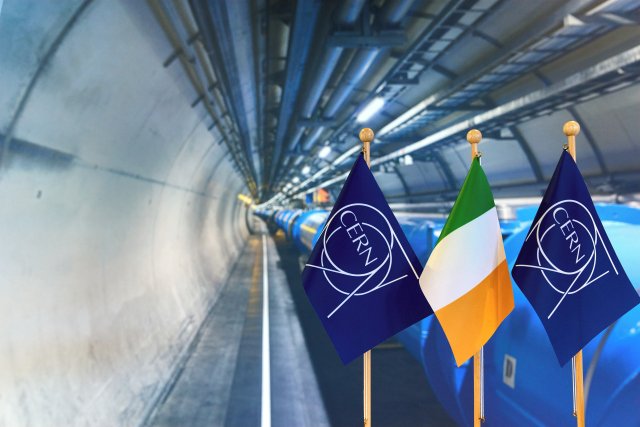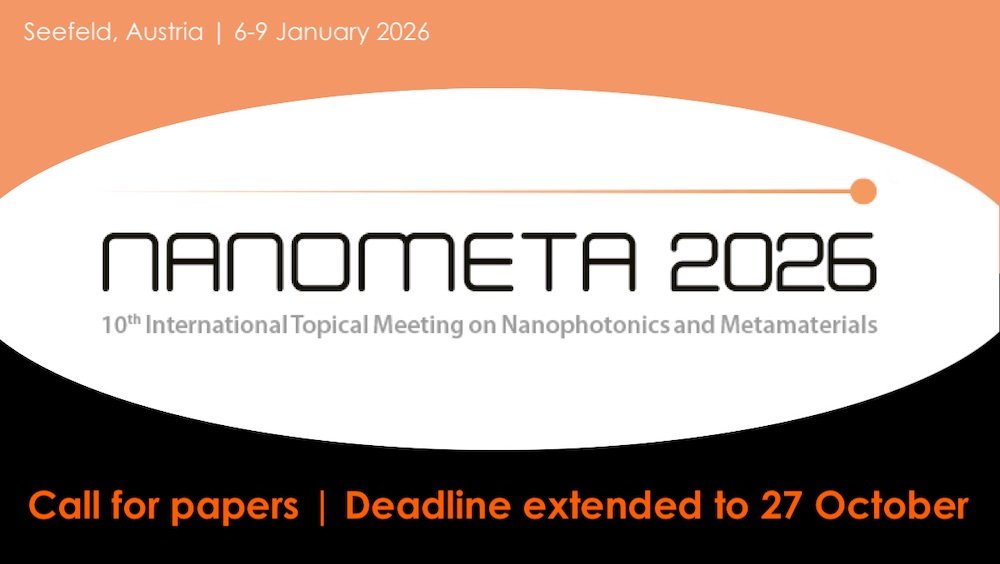The combined results add to physicists’ understanding and they validate the impressive collaborative effort between two competing – yet complementary – experiments
PRESS RELEASE OF THE T2K AND NOvA COLLABORATIONS
When the universe began, physicists expect there should have been equal amounts of matter and antimatter. But if that were so, the matter and antimatter should have perfectly canceled each other out, resulting in total annihilation. And yet, here we are. Somehow, matter won out over antimatter — but we still don’t know how or why.
Physicists suspect the answer may lie in the mysterious behavior of abundant yet elusive particles called neutrinos. Specifically, learning more about a phenomenon called neutrino oscillation — in which neutrinos change types, or flavors, as they travel — could bring us closer to an answer.
The international collaborations representing two neutrino experiments, T2K in Japan and NOvA in the United States of America, recently combined forces to produce their first joint results, published today in the journal Nature. This initial joint analysis provides some of the most precise neutrino-oscillation measurements in the field.
Johannes Gutenberg University Mainz (JGU) is represented in these collaborations by the members of the local T2K group, which is led by Professor Alfons Weber and Dr. Lukas Koch from the Experimental Particle and Astroparticle Physics group at the Institute of Physics.
“I have been involved in both these fantastic experiments. It is great to see the two collaborations working closely together to achieve a result that we could not have done individually. We now have a more robust understanding of the nature of neutrinos, and I am looking forward to seeing what we can achieve in the future,”says Weber, who is also member of the cluster of excellence PRISMA+.
“To me, the most exciting part of this joint result is the methodology that we developed to make it possible,” adds Koch. “It is far from trivial to combine the data of two experiments with different analysis methods, uncertainty models, and software frameworks. This great work will be the foundation for future combined results, not just from T2K and NOvA, but also from the next generation of neutrino beam experiments: Hyper-Kamiokande and DUNE.”
Different experiments, common goals
Despite their ubiquity, neutrinos are very difficult to detect and study. Even though they were first seen in the 1950s, the ghostly particles remain deeply enigmatic. Filling in gaps in our knowledge about neutrinos and their properties may reveal fundamental truths about the universe.
T2K and NOvA are both long-baseline experiments: they each shoot an intense beam of neutrinos that passes through both a near detector close to the neutrino source and a far detector hundreds of miles away. Both experiments compare data recorded in each detector to learn about neutrinos’ behavior and properties.
NOvA, the NuMI Off-axis νe Appearance experiment, sends a beam of neutrinos 810 kilometers from its source at the U.S. Department of Energy’s Fermi National Accelerator Laboratory near Chicago, Ill., to a 14,000-ton liquid-scintillator detector in Ash River, Minnesota.
The T2K experiment’s neutrino beam travels 295 kilometers from Tokai to Kamioka — hence the name T2K. Tokai is home to the Japan Proton Accelerator Research Complex (J-PARC) and Kamioka hosts the Super-Kamiokande neutrino detector, an enormous tank of ultrapure water located a kilometer underground.
Since the experiments have similar science goals but different baselines and different neutrino energies, physicists can learn more by combining their data.
“By making a joint analysis you can get a more precise measurement than each experiment can produce alone,” says NOvA collaborator Liudmila Kolupaeva. “As a rule, experiments in high-energy physics have different designs even if they have the same science goal. Joint analyses allow us to use complementary features of these designs. “
As long-baseline experiments, NOvA and T2K are ideal for studying neutrino oscillations, a phenomenon that can provide insight into open questions like charge-parity violation and the neutrino mass ordering. Two experiments with different baselines and energies have a better chance of disentangling the two effects than one experiment alone.
Interrogating neutrino oscillations
The mystery of neutrino mass ordering is the question of which neutrino is the lightest. But it isn’t as simple as placing particles on a scale. Neutrinos have miniscule masses that are made up of combinations of mass states. There are three neutrino mass states, but, confusingly, they don’t map to the three neutrino flavors. In fact, each flavor is made of a mix of the three mass states, and each mass state has a different probability of acting like each flavor of neutrino.
There are two possible mass orderings, called normal or inverted. Under the normal ordering, two of the mass states are relatively light and one is heavy, while the inverted ordering has two heavier mass states and one light.
In the normal ordering, there is an enhanced probability that muon neutrinos will oscillate to electron neutrinos but a lower probability that muon antineutrinos will oscillate to electron antineutrinos. In the inverted ordering, the opposite happens. However, an asymmetry in the neutrinos’ and antineutrinos’ oscillations could also be explained if neutrinos violate CP symmetry — in other words, if neutrinos don’t behave the same as their antimatter counterparts.
The combined results of NOvA and T2K do not favor either mass ordering. If the neutrino mass ordering is found to be normal, NOvA’s and T2K’s results are less clear on CP symmetry, requiring additional data to clarify. However, if future results show the neutrino mass ordering is inverted, the results published today provide evidence that neutrinos violate CP symmetry, potentially explaining why the universe is dominated by matter instead of antimatter.
“Neutrino physics is a strange field. It is very challenging to isolate effects,” says Professor Kendall Mahn, co-spokesperson for T2K. “Combining analyses allows us to isolate one of these effects, and that’s progress.”
The combined analysis does provide one of the most precise values of the difference in mass between neutrino mass states. With an uncertainty below 2%, the new value will enable physicists to make precision comparisons with other neutrino experiments to test whether the neutrino oscillation theory is complete.
What’s next
These first joint results do not definitively solve any mysteries of neutrinos, but they do add to physicists’ knowledge about the particles. Plus, they validate the impressive collaborative effort between two competing — yet complementary — experiments.
The NOvA collaboration consists of more than 250 scientists and engineers from 49 institutions in eight countries. The T2K collaboration has more than 560 members from 75 institutions in 15 countries. The two collaborations began active work on this joint analysis in 2019. It combines 6 years of data from NOvA, which began collecting data in 2014, and a decade of data from T2K, which started up in 2010. Alfons Weber initially developed the electronics for the T2K near detector. Now his team, funded by the Deutsche Forschungsgemeinschaft (DFG), is working with the upgraded T2K/ND280 detector to study how the presence of neutron in neutrino interactions influence the results. Lukas Koch has been part of the T2K collaboration since 2012 and has been leading the analysis group for neutrons in the near detector since 2024.
Both experiments continue to take data, and efforts are already underway to update the joint analysis with the new data.
“The joint analysis work has benefited both collaborations,” says Professor Patricia Vahle, co-spokesperson for NOvA. “We have a much better mutual understanding of the strengths and challenges of the different experimental setups and analysis techniques. “
“As shown in this very analysis, there are no truly ‘rivaling’ experiments because they all share a common goal of scientific study of a phenomenon,” says Dr. Tomáš Nosek, member of T2K. “Collaborating is naturally important for the transfer of knowledge, know-how and experience, and for sharing resources, ideas and tools. The T2K-NOvA collaboration is not merely a sum of T2K and NOvA collaborations. It is much, much more.”
Publication: The NOvA Collaboration, The T2K Collaboration. Joint neutrino oscillation analysis from the T2K and NOvA experiments. Nature (2025), https://doi.org/10.1038/s41586-025-09599-3
Image: T2K in Japan (left) and NOvA in the United States (right) are both long-baseline experiments: they each shoot an intense beam of neutrinos that passes through both a near detector close to the neutrino source and a far detector hundreds of kilometers away. Both experiments compare data recorded in each detector to learn about neutrinos’ behavior and properties.
Copyright: KEK High Energy Accelerator Research Organization
Related Links: https://gepris.dfg.de/gepris/projekt/517206441?language=en – Deutsche Forschungsgemeinschaft (DFG), project number 517206441: Search for Leptonic CP Violation with the T2K-II Experiment





